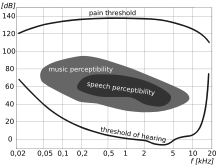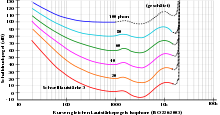Listening area
The listening area , also called the listening area or hearing field , is the frequency and level range of sound that can be perceived by the human ear . The listening area can also describe the individual hearing ability of a single person.
The listening area is determined at the bottom (i.e. for low levels) by the hearing threshold , i.e. the barely audible sound pressure level , and at the top by the pain threshold . On the left, the listening area is bounded by the lowest frequency that can be heard by humans with around 16 Hz to 21 Hz and on the right by the highest audible frequency with around 16,000 Hz to 20,000 Hz. The discomfort threshold on the hearing surface is slightly below the pain threshold and is also frequency-dependent. The hearing threshold is lowest between 2,000 Hz and 5,000 Hz, so this is where humans hear best, most of the sounds of spoken language also occur here , as well as noises that were important for people who were close to nature in earlier times (rustling leaves, animal sounds, etc.).
The four border areas of the hearing surface (hearing threshold, pain threshold, lowest and highest frequency) are also referred to as the hearing limit in their entirety . The hearing limits vary greatly from person to person, especially with age, the upper frequency limit decreases and the hearing threshold increases.
The relationships of the volume perception within the hearing field can be represented by curves of equal volume ( phon ).
Low frequencies below 16 Hz are referred to as infrasound and high frequencies above 21,000 Hz as ultrasound . While infrasound can only be perceived as vibration with decreasing frequency and sharply increasing levels or via structure-borne sound , the limit of perceptibility is very sharp at the upper frequency limit - higher tones are not perceptible. However, many animals can hear much higher frequencies than humans, e.g. B. some bats over 100,000 Hz.
The listening area can be reduced in the presence of hearing impairments . Even with increasing age, the hearing area often shrinks due to an increase in the hearing threshold, especially at high frequencies ( presbycusis ). The discomfort threshold can also decrease, see recruitment and thus reduce the listening area "from above".
Often two smaller fields are drawn in the listening field, the language field and the music field . These are the frequency and level ranges that are particularly important for the perception of speech or music.
literature
- Hubert Henle: The recording studio manual. 5th edition, GC Carstensen Verlag, Munich, 2001, ISBN 3-910098-19-3
- Horst Stöcker: Pocket book of physics. 4th edition, Verlag Harry Deutsch, Frankfurt am Main, 2000, ISBN 3-8171-1628-4
- Horst Kuchling: Pocket book of physics . 13th edition. Verlag Harri Deutsch (also VEB Fachbuchverlag Leipzig), Thun u. a. 1991, ISBN 3-8171-1020-0 , 23.2.1 listening area, p. 337 .
See also
- noise
- noise protection
- Hearing threshold (also resting hearing threshold)
- Hyperacusis (pathological hypersensitivity to sound)
- Misophony (hatred of (certain) noises)
Individual evidence
- ↑ a b Horst Kuchling: Taschenbuch der Physik . 15th edition. Verlag Harri Deutsch (also VEB Fachbuchverlag Leipzig), Thun u. a. 1991, ISBN 3-8171-1020-0 , 23.2.1 listening area, p. 337 .
- ↑ https://www.deutsche-apotheker-zeitung.de/daz-az/2012/daz-45-2012/hoeren-im-alter Clemens Bilharz: Hören im Alter in DAZ 2012, No. 45, p. 50
- ↑ https://www.ptb.de/cms/en/presseaktuelles/journals-magazines/ptb-annual-report/nicht-in-navigation/previous-annual-reports/annual-report-2014/aus-den-abteilungen /nachrichten-aus-abteilung-1/nachricht-abteilung-1.html?tx_news_pi1%5Bnews%5D=4705&tx_news_pi1%5Bcontroller%5D=News&tx_news_pi1%5Baction%5D=detail&tx_news_pi1%5Bpi%5D=News% 5D % 5D = 2014 & cHash = 475ec15424522ded4d43e2e0a4d72ee0 Robert Kühler, Johannes Hensel: Sound source for the objective investigation of the auditory perception of infrasound using magnetoencephalography (MEG) and magnetic resonance imaging (MRT) on the PTB website , accessed on December 28, 2017

